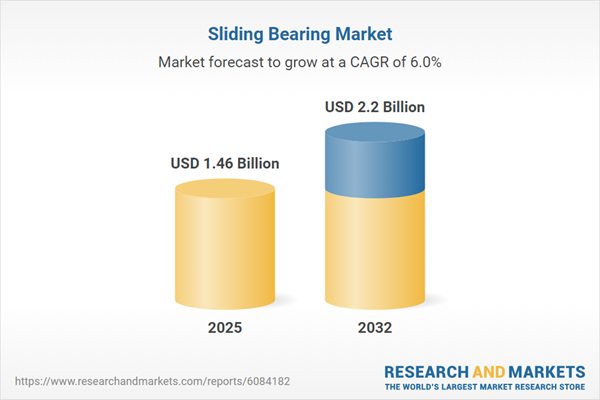Speak directly to the analyst to clarify any post sales queries you may have.
The sliding bearing market remains fundamental to contemporary industrial systems, increasingly shaped by technological innovation, sustainability mandates, and changing global trade conditions. Senior decision-makers must stay ahead of the rapid shifts impacting component performance, supply chains, and future-ready strategies for sliding bearing adoption.
Market Snapshot: Sliding Bearing Market
The Sliding Bearing Market grew from USD 1.38 billion in 2024 to USD 1.46 billion in 2025. It is expected to continue growing at a CAGR of 5.98%, reaching USD 2.20 billion by 2032. Market expansion reflects strong demand for reliable rotational mechanisms, with adoption driven by requirements across aerospace, energy, automotive, and heavy industrial sectors. This growth signals both the resilience of established applications and the emergence of advanced solutions tailored for evolving industry standards.
Scope & Segmentation
This report delivers an in-depth analysis of the sliding bearing market, breaking down critical factors that delineate regional and sectoral adoption, performance innovations, and shifting supply chain structures.
- End User: Aftermarket, Authorized Service Centers, Independent Repair Shops, Original Equipment Manufacturers (OEMs)
- Distribution Channel: Aftermarket, Direct OEM, Distributor, E-commerce
- Lubrication Type: Dry, Grease Lubricated, Oil Lubricated, Self-Lubricating variants
- Material Type: Bronze, Ceramic, Fiber Composite, Graphite Composite, Polymer, PTFE
- Product Type: Journal Bearings, Plain Bearings (Flanged, Sleeve), Spherical Bearings, Thrust Bearings
- Application: Aerospace (Aircraft Engine, Landing Gear), Automotive (Chassis, Engine, Transmission), Energy (Oil and Gas, Power Plant), Industrial (Construction, Machinery), Marine (Propeller Shaft)
- Region: Americas (United States, Canada, Mexico, Brazil, Argentina, Chile, Colombia, Peru), Europe, Middle East & Africa (United Kingdom, Germany, France, Russia, Italy, Spain, Netherlands, Sweden, Poland, Switzerland, United Arab Emirates, Saudi Arabia, Qatar, Turkey, Israel, South Africa, Nigeria, Egypt, Kenya), Asia-Pacific (China, India, Japan, Australia, South Korea, Indonesia, Thailand, Malaysia, Singapore, Taiwan)
- Key Players: AB SKF, Schaeffler AG, NSK Ltd., NTN Corporation, The Timken Company, JTEKT Corporation, RBC Bearings Incorporated, IKO International, CBC S.p.A., Federal-Mogul Holdings Corporation
Key Takeaways for Senior Decision-Makers
- Sliding bearings are vital for ensuring low-friction movement and extended machinery lifespan under demanding operational conditions.
- Advancements in digital monitoring are propelling proactive maintenance, reducing unplanned system downtime and strengthening asset integrity.
- Sustainability pressures drive adoption of bio-based lubricants and recyclable materials, supporting environmental compliance and resilient supply relationships.
- Trade realignments and regional supply chain strategies are influencing manufacturing footprints, as organizations diversify to manage geopolitical risks.
- OEMs and aftermarket segments demand differentiated designs and service protocols to meet distinct performance and regulatory criteria.
- Collaboration across materials research, digital simulation, and servicing is needed for future-ready product portfolios and customer retention.
Tariff Impact: Structural Shifts in Cost and Supply
Recent United States trade regulations create cost upticks for imported raw materials, particularly those involving high-grade alloys and composites. This has resulted in rising landed input expenses for offshore production facilities, prompting reevaluations of cost structures, supplier contracts, and regional alliances. Strategies such as dual-sourcing and local inventory buffering are being deployed, though they require new capital commitments and logistical coordination.
Methodology & Data Sources
The sliding bearing market study uses mixed-method research: expert interviews, exhaustive secondary source review, and quantitative supply chain analytics. Data triangulation validates trends across designer and procurement leader input, regulatory analysis, and technical documentation, resulting in comprehensive and reliable market insights.
Why This Report Matters
- Supports executive decisions on sourcing, segmentation, and product strategy by highlighting market dynamics, regulatory influences, and supply chain risks.
- Facilitates actionable planning for digital transformation, sustainability reporting, and regional investment priorities.
- Equips leaders with the segmentation, technology, and partnership context needed for successful long-term strategies in the sliding bearing industry.
Conclusion
The sliding bearing market is being redefined by technology integration, sustainability objectives, and regulatory change. This report offers decision-makers the clarity needed to navigate complexity and drive future-focused growth in a competitive landscape.
Table of Contents
3. Executive Summary
4. Market Overview
7. Cumulative Impact of Artificial Intelligence 2025
Companies Mentioned
The companies profiled in this Sliding Bearing market report include:- AB SKF
- Schaeffler AG
- NSK Ltd.
- NTN Corporation
- The Timken Company
- JTEKT Corporation
- RBC Bearings Incorporated
- IKO International, Inc.
- CBC S.p.A.
- Federal-Mogul Holdings Corporation
Table Information
| Report Attribute | Details |
|---|---|
| No. of Pages | 194 |
| Published | November 2025 |
| Forecast Period | 2025 - 2032 |
| Estimated Market Value ( USD | $ 1.46 Billion |
| Forecasted Market Value ( USD | $ 2.2 Billion |
| Compound Annual Growth Rate | 5.9% |
| Regions Covered | Global |
| No. of Companies Mentioned | 11 |









